MUMBAI HARBOUR – A GRAVEYARD FOR MAJOR SHIPS?
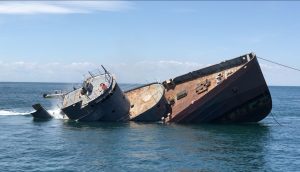
The Mumbai harbour, once treated as the best and safest docking point for ships this side of the Suez, has of late evolved as the graveyard for several ocean-going vessels. Over the decades, the Mumbai port underwent huge expansion, with the extension of berths and cargo handling capacities.
The shallow shores of the port of witnessed several vessel accidents and sinkage. Not only the naval ships, rather ranging from a floating restaurant to huge merchant ships and passenger’s ship to barges and tugs have simply disappeared from the Mumbai harbor, causing nightmares to the shipping companies.
A few of the major ships sank in the Mumbai Port-
14th April 1944 Bombay explosion
The Bombay explosion (or Bombay docks explosion) happened on 14 April 1944, in the  Victoria
Dock of Bombay (Mumbai) when the freighter SS Fort Stikine, bearing a
mixed cargo of cotton bales, gold, and ammunition containing around
1,400 tons of explosives, caught fire and was ruined in two giant
blasts, scattering debris, sinking nearby ships and causing fire to the
area, killing around 800 to 1,300 people. Some 80,000 people were made
homeless and 71 firemen lost their lives in the occurrence.
Victoria
Dock of Bombay (Mumbai) when the freighter SS Fort Stikine, bearing a
mixed cargo of cotton bales, gold, and ammunition containing around
1,400 tons of explosives, caught fire and was ruined in two giant
blasts, scattering debris, sinking nearby ships and causing fire to the
area, killing around 800 to 1,300 people. Some 80,000 people were made
homeless and 71 firemen lost their lives in the occurrence.
24 February 1944 sailing from Birkenhead via Gibraltar, she reached
at Bombay on 12 April 1944. Her cargo contained 1,395 tons of explosives
containing 238 tons of sensitive “A” explosives, torpedoes, mines,
shells, and munitions. She also contained super marine Spitfire fighter
aircraft, raw cotton bales, barrels of oil, timber, scrap iron and
nearly £890,000 of gold bullion in bars in 31 crates. The ship’s
captain, Alexander James Naismith objected over a “mixture” of cargo
being loaded on the ship. Nearly 87,000 bales of cotton and lubricating
oil were loaded at Karachi. During those days the transportation of
cotton through the sea 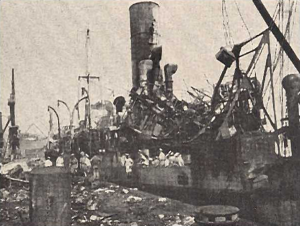 route
was irresistible for the merchants, as transporting cotton by rail from
Punjab and Sindh to Bombay was outlawed at that time. Capt. Naismith,
who lost his life in this explosion, labeled the cargo as “just about
everything that will either burn or blow up.” The vessel was awaiting to
be unloaded on 12 April, after forty-eight hours of berthing. Around
1400 hrs the crew was alerted to a fire in No. 2 hold. Despite pumping
of 900tons of water the fire could not be controlled. The dense smoke
blocked the vision and finally, after the 15 minutes, there was an
explosion.
route
was irresistible for the merchants, as transporting cotton by rail from
Punjab and Sindh to Bombay was outlawed at that time. Capt. Naismith,
who lost his life in this explosion, labeled the cargo as “just about
everything that will either burn or blow up.” The vessel was awaiting to
be unloaded on 12 April, after forty-eight hours of berthing. Around
1400 hrs the crew was alerted to a fire in No. 2 hold. Despite pumping
of 900tons of water the fire could not be controlled. The dense smoke
blocked the vision and finally, after the 15 minutes, there was an
explosion.
It took three days to control the fire and later, 8,000 men were on constant work mode for seven months to remove around 500,000 tons of debris and bring the docks back into action. The analysis of the explosion identified the cotton bales as probably being the cause of the fire. It was critical of several errors:
- Keeping the cotton below the munitions,
- No display of the red flag (B flag) used to indicate a “dangerous cargo on board”,
- Delay in unloading the explosives,
- No usage of steam injectors to contain the fire, and
- Delay in alerting the local fire brigade.
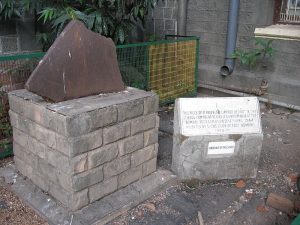
Many families lost all their belongings and were left with just the clothes on their backs. Thousands became destitute. It was anticipated that about 6,000 firms were affected and 50,000 lost their jobs. The government took full accountability for the disaster and monetary compensation was paid to citizens who made a claim for loss or damage to property. Many intact gold bars rained in the houses covering the range. Some as late as were found in February 2011, and returned to the government. A live shell weighing almost 45 kg (100 lb) was also found in October 2011.
1947 Ramdas ship disaster
The 1947 Ramdas ship disaster occurred near Bombay (Mumbai) in India.
The Indian passenger ship SS Ramdas, while bound for Rewas in
Maharashtra, drifted on 17 July 1947, near Gull Island (Kashyacha
Khadak), ten miles away from Colaba Point, taking the lives of 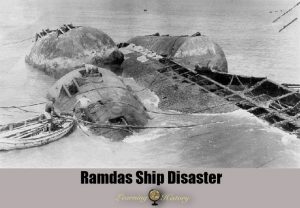 the
690 people Of the 713 passengers on board. She was caught in violent
storms and high seas. While she was sailing towards the island of
Kashyacha Khadak, one of the waves caught her on the starboard side,
leading in the passengers rushing to the port side and resulting her to
capsize.
the
690 people Of the 713 passengers on board. She was caught in violent
storms and high seas. While she was sailing towards the island of
Kashyacha Khadak, one of the waves caught her on the starboard side,
leading in the passengers rushing to the port side and resulting her to
capsize.
23rd March 2010 Coast Guard vessel drifted after collision
A Coast Guard ship sank after a privately-owned merchant vessel rammed into it in the Mumbai Harbour. Over 40 sailors and technicians on the ship, identified as Indian Coast Guard Ship Vivek, were rescued. The accident occurred around 6.30 p.m. when ICGS Vivek was undergoing repairs and refit at Berth No. 10 of Indira Docks. The private merchant vessel MV Global Purity collided into Vivek, making a deep hole in the Coast Guard ship. Resulting in that, it sank within an hour. The vessel was used to carry helicopters for rescue operations. The cause of the collision remained unclear, it is anticipated that the private ship collided into Vivek when the Coast Guard ship’s berth door was suddenly opened up.
When talking of a survey conducted by Director General of Shipping in 2010, the final report came that nearly 10 ships, including a few offshore supply vessels, had sunk in the past 13 years in the Mumbai Port trust. Making it a question whether Mumbai port is a graveyard of ships? The remains of the previous sunk ships are already a threat for the ships and fishing boats. More than 30 vessels had become a threat to the lives of the seafarers. The 30 odd vessels have been reduced to rusted buckets after they were anchored in Mumbai harbor since July 2007. The rust that comes out from these ships is causing an ecological threat to the marine fauna in the overall region.
9th Aug 2010, MSC Chitra
On August 7, the infamous collision of mv MSC Chitra and MV
Khalijia-3 took place in the main navigation channel of the port near
Prongs Reef Lighthouse. Apart from the disruption of ship traffic and
loss of cargo, 400 tonnes of oil was spilled. With a thick oil slick
that spread for about seven nautical miles around the ships, the damage
could have been devastating. 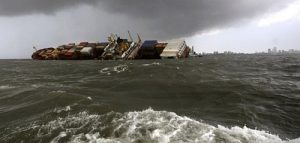 but the monsoon current and the stormy waters broke up and dispersed the slick.
but the monsoon current and the stormy waters broke up and dispersed the slick.
On August 31 last year, tragedy was averted when a coastal tramp called mv Nand Hajara, which was unloading a consignment, swung against mv Beas Dolphin. Water rushed into Nand Hajara, but since it was at the dock, help was on hand and it was prevented from sinking. Five months later, on January 31, 2011, a Nilgiri class frigate of the Indian Navy was not so lucky. INS Vindhyagiri collided with the Cyprus-registered container cargo ship mv Nordlake and sank. Then, on June 11, the 9,300-tonne Singapore-flagged ship mv Wisdom broke its towing cable in heavy seas and ran aground on Juhu Beach.
4th Aug 2011, Ship with 60,000 t coal sinks off Mumbai coast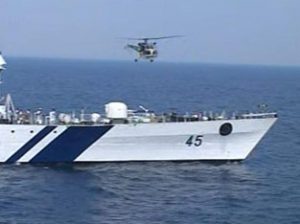
A Panama registered bulk carrier carrying 60,000 tonnes of coal sank 20-nautical miles off the Mumbai coast. No causalities were reported. The vessel sailed from Indonesia to Dahej port in Gujarat. The cargo loaded at an Indonesian port belongs to the Gujarat-based Adani Enterprises, the largest importer of coal in the country. The coal was for the third-party supply and was fully insured, a spokesperson for the Adani Group said.
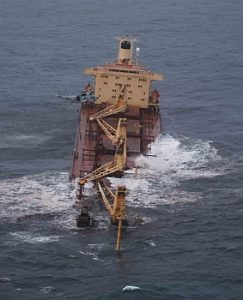
The ship MV Rak Carrier, owned and managed by Delta Shipping Marine Services, Qatar, and classed with Lloyds Register of Shipping, contained 290 tonnes of fuel and 50 tonnes of diesel. As the ship started drowning following ingress of water, the crew jumped off the ship and were later rescued by a helicopter. The incident was definitely a threat to Pollution in the surrounding.
This was the third incident involving a merchant ship sinking or running aground near the Mumbai coast after the onset of the monsoon in 2011. These incidents definitely raise eyebrows towards the coastal security.
M.T. Pavit
Meanwhile, the 1,000-tonne Panama-flagged merchant vessel, m.t. Pavit that ran aground near Mumbai’s Juhu Beach has sent the Navy and Ministry of Defence into a tizzy.
The incident, which occurred less than a month after M.V. Wisdom, another vessel was towed from there, raised fear about lack of coordination among security agencies. The ship has been reportedly drifting since July 1. But, the Indian Navy, the Coast Guard, and the state coastal police failed to detect the vessel. Naval Chief Admiral Nirmal Verma has sought a high-level inquiry and detailed report on m.v. Pavit that drifted into Indian waters on June 29, 2011.
The unmanned, adrift vessel was found grounded near the shore of Mumbai’s Juhu-Versova beach on June 31. The (DGS) sent a notice to the owners of Pavit after which they carried out a ground assessment and would submit a salvage plan. DGS initiated an inquiry into the incident.
14th Aug 2013, Explosion at Mumbai port sinks Indian submarine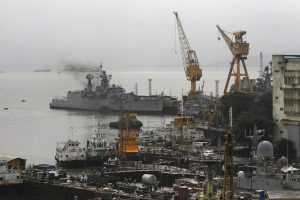
A series of explosions aboard a Russian-built Indian naval submarine partially sank the vessel docked at the port in Mumbai killing 18 crew members. This is the 2nd explosion on a Russian-made sub in India in 3 years.
6th April 2014, Fire on INS Matanga in Mumbai dock
Indian Navy’s fleet was hit by yet another blot on Sunday after a fire broke out on Indian Naval Ship (INS) Matanga at the Naval Dockyard, Mumbai. Fortunately, there were no casualties.
List of mishaps involving Naval and Coast Guard vessels at Mumbai Port:
INS Jyoti (March 28, 1998) – Four workers killed in a gas explosion during repairs at the Naval Dockyard, Mumbai.
INS Trishul (December 27, 2005) – INS Trishul and MV Ambuja Laxmi collided near Mumbai.
INS Sindhughosh (January 7, 2008) – Submarine collided with MV Leeds Castle off Mumbai’s coast.
ICGS Vivek (March 23, 2010) – Coast Guard ship undergoing repairs inside Indira Docks of Mumbai Port Trust sank after MV Global Purity rammed into ICGS Vivek.
INS Sindhuratna & INS Sindhukesri (June 28, 2010) – Two Kilo class submarines collide with each other inside Mumbai’s Naval Dockyard while berthing.
INS Sindhurakshak (August 30, 2010) – Explosion in the battery compartment 60 nautical miles off Mumbai’s coast resulted in two sailors losing their life and another two getting injured.
INS Vindhyagiri (January 30, 2011) – INS Vindhyagiri collides with MV Nordlake and catches fire the next day inside the Naval Dockyard, Mumbai. It sank while the flames were being doused.
INS Sindhurakshak (August 14, 2013) – Eighteen crew members on board – three officers and 15 sailors – were killed when blasts ripped through the torpedo compartment of the INS Sindhurakshak while the submarine was berthed in Mumbai harbour.
INS Viraat (September 2013) – Fire broke out near the officer’s mess of the aircraft carrier off the Mumbai coast. No casualties were reported.
INS Tarkash (December 2013) – A stealth frigate which conducted several overseas missions, INS Tarkash suffered damage to its hull when it hit the jetty while docking at the Mumbai. There were no casualties.
INS Betwa (January 22, 2014) – The indigenously built frigate ran aground and collided with an unidentified object while approaching the Mumbai harbour. The frigate’s sonar system was found to be cracked, leading to faulty readings and ingress of salt water into sensitive equipment.
INS Sindhughosh (January 2014) – The leading ship of her class of diesel-electric submarines, the Sindhughosh ran aground at the naval harbour in Mumbai. The submarine was re-floated and did not suffer much damage. At the time of the incident, it was fully armed, carrying its entire complement of 70 personnel, all of whom were safe.
INS Sindhuratna (February 26, 2014) – Two sailors died and seven members of the 94-strong crew were evacuated after inhaling smoke aboard the diesel-powered submarine following a fire. A board of inquiry in its preliminary report said that fire in some cables led to the smoke in the third compartment.
INS Kolkata / Yard 701 (March 7, 2014) – An officer was killed and a worker injured after inhaling carbon dioxide gas which leaked from a container in the advanced warship at Mumbai’s Mazagon Dock Limited.
5th December 2016 Capsized Indian Navy Frigate Righted in Mumbai Dock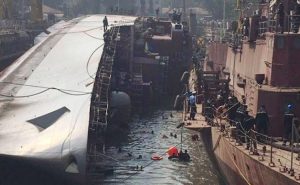
US-based salvage company RESOLVE Marine Group has completed the salvage of the INS Betwa, the Indian Navy frigate that capsized inside a dock at a naval shipyard in Mumbai.
25th May 2018 The floatel Ark Deck Bar 
Popular floating restaurant ‘Ark Deck Bar’, off the coast near Bandra, capsized and sank under the possible impact of huge tidal waves. The ship had sunk on May 25 after it hit a rock while anchoring.
21st May 2018, CMA CGM Containership Hits Pier in India
The Hong Kong-flagged CMA CGM Mumbai had a nominal TEU capacity of 10,100 and operated on the FAL – ASIA – EUROPE service route. Delivery was to be made on May 21, 2018. It was operated by Seaspan. The ship was coming in to dock when it lost control and struck the pier despite efforts to stop the vessel.
3rd Aug 2019
The cargo ship MV Nand Aparma was driven ashore by a storm 60 nautical miles (110 km; 69 mi) north of Mumbai, India.
While shipping companies blame the Mumbai port trust for these accidents, as it charges hefty anchorage fees for the safe upkeep of the approach channel, port authorities point an accusing finger at the shipping liners for poor maintenance of vessels. The rust that comes out from these ships is causing an ecological threat to the marine fauna in the overall region.
The authorities are tackling this threat so far, but few quicker and prompt actions are required to keep the economy balanced and the seafarers safe. However, Mumbai’s expanding growth and population pressure constrains the growth of the port. There was a time when Mumbai Port was considered to be one of the safest port, hopefully in coming days too it remains the same, and not the graveyard for the ships.
